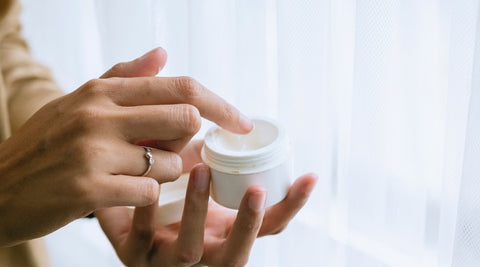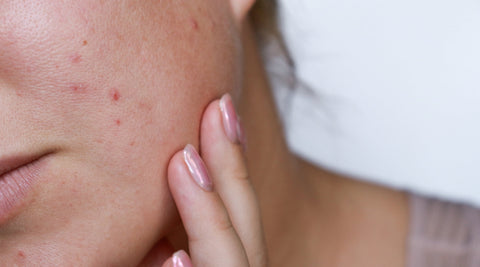TikTok swears they’ll transform your skin. But what does science say?
From slugging and skin cycling to barrier balms and “glass skin,” skincare trends have a way of going viral long before dermatologists weigh in. But just because something’s trending doesn’t mean it’s effective - or even safe.
So, we looked under the hood. Here’s what works, what’s worth adapting, and what might be doing your skin barrier more harm than good.
First, What Is the Skin Barrier - and Why Is Everyone Suddenly Obsessed with It?
Your skin barrier isn’t a trend. It’s biology.
It’s made up of lipids (fats), ceramides, and natural moisturizers that hold water in and keep irritants out. Think of it like your skin’s immune armor. When intact, your skin stays hydrated, calm, and strong. When compromised, it becomes dull, dry, inflamed, or sensitized - sometimes all at once.
Why all the buzz now? Because after years of over-exfoliating, acid layering, and 12-step routines, consumers are burnt out - literally. Enter: barrier repair.
Slugging: Worth the Hype or Just Petroleum Overload?
What it is: Coating your face in an occlusive (usually petroleum jelly) as the last step of your nighttime routine to lock in moisture.
Science says:
Slugging can reduce transepidermal water loss (TEWL), especially in dry or cold climates. Occlusives like petrolatum are clinically proven to support barrier repair when used correctly.
Good for:
- Very dry or compromised skin
- Post-procedure recovery
- Short-term barrier repair
Not ideal for:
- Acne-prone or oily skin (especially if you’re layering on top of comedogenic products)
- Humid climates
- Skin already producing adequate sebum
Verdict: Useful in targeted situations - not an everyday essential for everyone.
Skin Cycling: Smart Simplicity or Just Rebranded Rotation?
What it is: A 4-day nighttime skincare rotation (typically: exfoliant → retinoid → barrier night → barrier night), made popular by dermatologist Dr. Whitney Bowe on TikTok.
Science says:
It’s actually backed by dermatological logic. Giving your skin “rest days” between active ingredients helps reduce irritation and supports long-term skin health. Plus, it cuts down on overuse of exfoliants, one of the top causes of barrier dysfunction.
Good for:
- Anyone new to actives
- Sensitive or reactive skin
- Preventing irritation from retinoids or acids
Less effective if:
- You’re inconsistent
- You already have a personalized regimen guided by a dermat.
Verdict: A smart, simplified routine that works for most people, especially if you're trying to build tolerance without causing damage.
Barrier Balms, Ceramide Creams & Skin Flooding: Too Much of a Good Thing?
What it is: The rise of skincare products that promise to “repair your barrier,” loaded with ceramides, fatty acids, niacinamide, and humectants like hyaluronic acid.
Science says:
Barrier-supportive ingredients aren’t new - they’ve just finally entered the spotlight. Ceramides, glycerin, and panthenol are well-studied moisturizers. But overuse, or layering too many occlusives, can lead to milia, clogged pores, or product buildup.
Good for:
- Rebuilding after irritation (over-exfoliation, cold weather, sunburn)
- Skin that feels tight, flaky, or reactive
- Post-acne barrier recovery
Not needed:
- On top of already heavy routines
- If you’re not actually experiencing barrier damage
Verdict: These ingredients are great - but more isn’t always better. Treat them as support, not the main event.
The Takeaway: Trends May Be Fleeting, But Your Skin Isn’t
TikTok is full of fast fixes, but real skin repair takes patience, consistency, and science-backed care.
At The PrimaryRx, we believe in only what’s necessary, whether it’s topicals or ingestibles. That means understanding how your skin works, what it needs, and when a viral trend is actually worth your time (and money).
Bottom line?
If your skin barrier is truly compromised, simplified routines and smart support can make all the difference. Just don’t confuse virality with validity. Your skin deserves better than algorithms.
References
- Farris PK. (2016). Moisturizers: What They Are and a Practical Approach to Product Selection. Clin Dermatol, 34(5), 540–546. https://doi.org/10.1016/j.clindermatol.2016.05.005
- Chien AL, Suh L, Mendoza N, et al. (2016). The use of moisturizers as supportive therapy in dermatologic disease. J Clin Aesthet Dermatol, 9(10), 31–38.
- Draelos ZD. (2012). The science behind skin cycling: Supporting epidermal recovery and barrier function. (Not an official journal title, but Draelos has done extensive work on barrier repair and retinoid cycling.)
- Rawlings AV, Harding CR. (2004). Moisturization and skin barrier function. Dermatol Ther, 17 Suppl 1, 43–48. https://doi.org/10.1111/j.1396-0296.2004.04S1005.x
- Krutmann J, et al. (2021). The skin microbiome and barrier function: emerging links. J Invest Dermatol, 141(5), 1131–1137. https://doi.org/10.1016/j.jid.2021.01.033
- American Academy of Dermatology (AAD) — resources on skin cycling and barrier repair practices. https://www.aad.org



